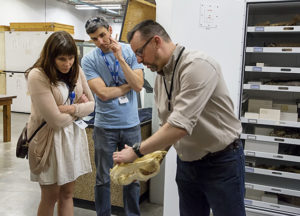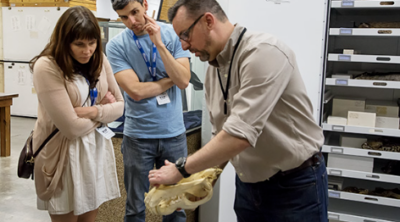Pondering the possibility of cross-curricular activities and seeking some ideas? Look no further! Inspired by the background of one of the scientists in The Walking Classroom’s Science Career Series podcasts, Ben Hess, we decided it might be fun to merge mammals and math for a March academic adventure!
Collections Manager of Mammals at the North Carolina Museum of Natural Sciences, Ben Hess earned a B.S. in Biology and minored in mathematics. Working towards a Ph.D. in mammalogy, he studied the geographic distribution of small mammals, specifically northern and southern short-tailed shrews.
The podcast with Mr. Hess is easily accessible, either via our website or on WalkKits in three of The Walking Classroom’s program offerings (4-#97, 5-#103, STEM-#59).
 In the podcast, Mr. Hess mentions what led him to a career in mammalogy. Interestingly, he originally wanted to be a math teacher, but he loved the outdoors. A summer job doing mammal surveys in the woods of Pennsylvania brought the two together and piqued his interest in mammals. The rest is history … well, actually more of a cross between math and science!
In the podcast, Mr. Hess mentions what led him to a career in mammalogy. Interestingly, he originally wanted to be a math teacher, but he loved the outdoors. A summer job doing mammal surveys in the woods of Pennsylvania brought the two together and piqued his interest in mammals. The rest is history … well, actually more of a cross between math and science!
Sorting Systems
Mr. Hess reveals that the mammal collection is basically a library for folks interested in mammals. Like a library, it needs to have a sorting system! This is where some math skills come in handy. After all, measuring, categorizing, and classifying (skills used often in math!) are critical components in the management of most collections.
These specific skills allow people to analyze and separate all kinds of things—from shapes to books to … animal specimens. In Mr. Hess’s case, these skills help him distinguish samples of species and subspecies from particular places and times. This way, he can separate them into distinct groups. Separation into different categories helps a collection manager keep things organized. It also makes it easier for folks to find things when they are searching for a particular item!
Classroom Classification
How can you bring classification into your classroom? Start by introducing your students to sorting and categorizing. You might want to use the Classification Schemes activity from the Utah Education Network suggested in the lesson plan for this podcast. Or try a different option for teaching classification to your students! The Animal Classification podcast (4-#41, STEM-#32, Combined-#131) is another great resource.
Looking for ways for students to practice those animal classification skills? Challenge them via a quick classification game that introduces a few additional animal classes!
Mammals, Math, and More!
Next, direct the focus to mammals with a quick overview of mammal characteristics and common examples. It might be fun to have your students be explorers! Let them do the research on mammal lifespans or physical dimensions. They can then compile the numerical data they have discovered by contributing to a class chart or table!
Are your students in need of some graphing practice? Have them work in small groups to analyze data you have provided or which they have recorded and then have them create an appropriate graph to visually share the information.
 Merge mammals with your math content too! Include numerical or statistical data about this animal class when you create word problems for classwork, homework, or math assessments. Additional resources to extend your study of animal classification and mammals are easily available, so explore on your own. You may find some interesting possibilities for other cross-curricular links!
Merge mammals with your math content too! Include numerical or statistical data about this animal class when you create word problems for classwork, homework, or math assessments. Additional resources to extend your study of animal classification and mammals are easily available, so explore on your own. You may find some interesting possibilities for other cross-curricular links!






Leave a Reply